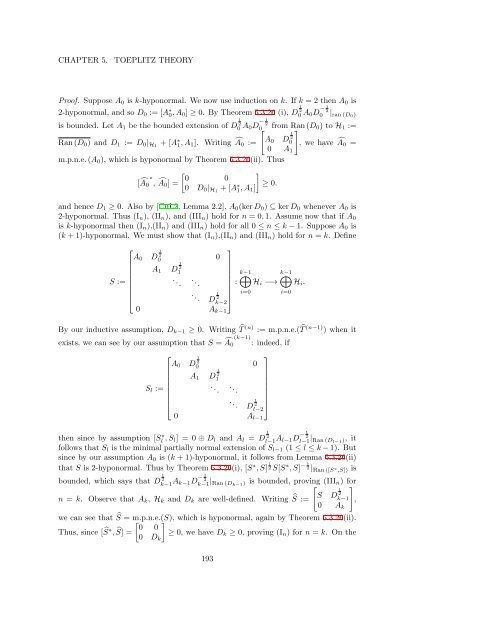Woo Young Lee Lecture Notes on Operator Theory
Woo Young Lee Lecture Notes on Operator Theory
Woo Young Lee Lecture Notes on Operator Theory
Create successful ePaper yourself
Turn your PDF publications into a flip-book with our unique Google optimized e-Paper software.
CHAPTER 5.<br />
TOEPLITZ THEORY<br />
Proof. Suppose A 0 is k-hyp<strong>on</strong>ormal. We now use inducti<strong>on</strong> <strong>on</strong> k. If k = 2 then A 0 is<br />
2-hyp<strong>on</strong>ormal, and so D 0 := [A ∗ 0, A 0 ] ≥ 0. By Theorem 5.3.26 (i), D 1 2<br />
0 A 0 D − 1 2<br />
0 | ran (D0)<br />
is bounded. Let A 1 be the bounded extensi<strong>on</strong> of D 1 2<br />
0 A 0 D − 1 2<br />
0[<br />
from Ran<br />
]<br />
(D 0 ) to H 1 :=<br />
Ran (D 0 ) and D 1 := D 0 | H1 + [A ∗ 1, A 1 ]. Writing Â0 :=<br />
A 0 D 1 2<br />
0 , we have<br />
0 A Â0 =<br />
1<br />
m.p.n.e. (A 0 ), which is hyp<strong>on</strong>ormal by Theorem 5.3.26(ii). Thus<br />
[Â0∗<br />
, Â 0 ] =<br />
[ ]<br />
0 0<br />
0 D 0 | H1 + [A ∗ ≥ 0.<br />
1, A 1 ]<br />
and hence D 1 ≥ 0. Also by [CuL2, Lemma 2.2], A 0 (ker D 0 ) ⊆ ker D 0 whenever A 0 is<br />
2-hyp<strong>on</strong>ormal. Thus (I n ), (II n ), and (III n ) hold for n = 0, 1. Assume now that if A 0<br />
is k-hyp<strong>on</strong>ormal then (I n ),(II n ) and (III n ) hold for all 0 ≤ n ≤ k − 1. Suppose A 0 is<br />
(k + 1)-hyp<strong>on</strong>ormal. We must show that (I n ),(II n ) and (III n ) hold for n = k. Define<br />
⎡<br />
⎤<br />
A 0 D 1 2 0 0<br />
A 1 D 1 2<br />
1<br />
S :=<br />
. .. . ..<br />
⊕k−1<br />
⊕k−1<br />
: H i −→ H i .<br />
⎢<br />
⎣<br />
. ..<br />
1 ⎥ i=0<br />
i=0<br />
D<br />
2 ⎦<br />
k−2<br />
0 A k−1<br />
By our inductive assumpti<strong>on</strong>, D k−1 ≥ 0. Writing ̂T (n) := m.p.n.e.( ̂T (n−1) ) when it<br />
exists, we can see by our assumpti<strong>on</strong> that S = Â0(k−1)<br />
: indeed, if<br />
⎡<br />
⎤<br />
A 0 D 1 2 0 0<br />
A 1 D 1 2<br />
1<br />
S l :=<br />
. .. . ..<br />
⎢<br />
⎣<br />
. ⎥ ..<br />
D 1 2 ⎦<br />
l−2<br />
0 A l−1<br />
then since by assumpti<strong>on</strong> [Sl ∗, S l] = 0 ⊕ D l and A l = D 1 2<br />
l−1<br />
A l−1 D − 1 2<br />
l−1 | Ran (D l−1 ), it<br />
follows that S l is the minimal partially normal extensi<strong>on</strong> of S l−1 (1 ≤ l ≤ k − 1). But<br />
since by our assumpti<strong>on</strong> A 0 is (k + 1)-hyp<strong>on</strong>ormal, it follows from Lemma 5.3.26(ii)<br />
that S is 2-hyp<strong>on</strong>ormal. Thus by Theorem 5.3.26(i), [S ∗ , S] 1 2 S[S ∗ , S] − 1 2 | Ran ([S∗ ,S]) is<br />
bounded, which says that D 1 2<br />
k−1<br />
A k−1 D − 1 2<br />
k−1 | Ran (D k−1 ) is bounded, proving (III n ) for<br />
]<br />
n = k. Observe that A k , H k and D k are well-defined. Writing<br />
[S Ŝ := D 1 2<br />
k−1 ,<br />
0 A k<br />
we can see that Ŝ = m.p.n.e.(S), [ ] which is hyp<strong>on</strong>ormal, again by Theorem 5.3.26(ii).<br />
0 0<br />
Thus, since [Ŝ∗ , Ŝ] = ≥ 0, we have D<br />
0 D k ≥ 0, proving (I n ) for n = k. On the<br />
k<br />
193













